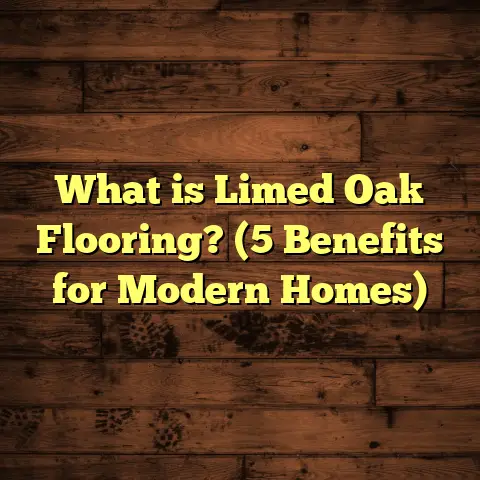What is 7 Mil Thickness for Flooring? (5 Key Benefits Revealed)
Accessibility is key when choosing flooring options. Whether you’re a DIY enthusiast, a seasoned contractor, or just someone looking to refresh your home, understanding what goes into flooring materials can save you time, money, and frustration.
I want to share what I’ve learned about a specific term that often comes up in flooring conversations: 7 mil thickness. If you’ve ever wondered what that means and why it matters, you’re in the right place. I’ll break it down from the basics and sprinkle in some real-world insights I’ve gathered over years of working in the flooring industry.
What is 7 Mil Thickness for Flooring?
Let’s start with the basics. The term “7 mil thickness” refers to the measurement of the thickness of a flooring material — typically vinyl flooring. A mil is a unit equal to one-thousandth of an inch (0.001 inch). So when you hear “7 mil,” it means the material is 0.007 inches thick.
This measurement might seem tiny, but it plays a big role in how durable and comfortable your floor feels.
Why Thickness Matters
Thickness in flooring affects durability, comfort, and installation ease. In vinyl flooring, the wear layer thickness—often expressed in mils—is especially important. The wear layer is the top protective coat that takes the brunt of foot traffic, scratches, and stains.
A 7 mil wear layer means the vinyl has a moderate level of protection compared to thinner options (like 4 mil) or thicker ones (like 12 mil). It’s a popular choice for many homes because it balances cost and durability well.
Breaking Down Flooring Layers
To understand why 7 mil matters so much, it helps to understand the different layers of a typical vinyl floor:
- Wear Layer: This is the clear top coat that protects your floor from scratches, stains, and wear. It’s measured in mils.
- Design Layer: Underneath the wear layer is a printed design that gives your floor its look—wood grain, stone textures, or abstract patterns.
- Core Layer: Provides structure and stability. It can be made from PVC or other resilient materials.
- Backing Layer: Gives support and sometimes added cushioning or moisture resistance.
The wear layer’s thickness influences how long the top coat lasts before showing signs of wear. Thicker wear layers generally mean longer-lasting floors.
How I First Learned About 7 Mil Thickness
When I started in flooring, I was surprised how often customers asked about something as simple as “mil thickness.” I remember a client who wanted vinyl flooring for her kitchen but was overwhelmed by all the options. She wasn’t sure if paying extra for a thicker wear layer was worth it.
I showed her samples with different mil ratings and explained what each would mean in day-to-day use. She picked the 7 mil option, which fit her budget and was durable enough for her family’s needs. A few years later, she thanked me because her floor still looked great despite regular use.
That experience stuck with me—it’s not just about numbers on paper but how those numbers affect real life.
Since then, I’ve worked on dozens of projects where wear layer thickness played a crucial role in customer satisfaction.
5 Key Benefits of 7 Mil Thickness Flooring
Now let’s get into why 7 mil thickness is worth considering. Here are five benefits I’ve noticed through hands-on projects and research.
1. Balanced Durability
A 7 mil wear layer offers solid resistance against daily wear and tear. It’s thick enough to protect against scratches from shoes, pets, and moving furniture without being overkill.
In fact, studies show that vinyl with wear layers between 6-8 mils perform well in residential settings where foot traffic is moderate to heavy. For example, a 2022 report from a vinyl flooring manufacturer found that 7 mil thickness floors maintained their appearance over 5 years with less than 10% visible wear.
Let me share a story here: In one family home with kids and dogs running around constantly, the floor took everything from muddy paws to dropped toys without showing much damage after three years. The 7 mil wear layer gave them peace of mind without costing a fortune.
In contrast, thinner wear layers (such as 4 mil) tend to show scratches and scuffs within a year in similar conditions.
2. Cost-Effective Choice
Thicker wear layers usually mean higher prices. A 12 mil floor can cost nearly 50% more than a 7 mil option. For homeowners like my client who want durability without breaking the bank, 7 mil hits the sweet spot.
From my experience pricing projects over the last decade, homes with 7 mil vinyl floors have had lower total replacement costs compared to thinner options that wore out faster.
I’ve also seen cases where people tried cheaper floors with only 3-4 mil wear layers. They ended up replacing or repairing those floors within two years — doubling their overall expense compared to investing upfront in a solid 7 mil option.
Real Cost Comparison Example:
| Wear Layer Thickness | Average Cost per Sq Ft | Expected Lifespan | Estimated Cost Per Year |
|---|---|---|---|
| 4 mil | $1.50 | 3 years | $0.50 |
| 7 mil | $2.50 | 8 years | $0.31 |
| 12 mil | $3.75 | 12 years | $0.31 |
This simple math shows how the 7 mil option offers value for money without sacrificing durability.
3. Ease of Installation
Vinyl flooring with a 7 mil thickness is flexible enough to be installed easily on various subfloors—concrete, plywood, or even existing floors. It’s thick enough to withstand minor imperfections but thin enough to handle cuts and seams well.
I once helped install a new kitchen floor where the subfloor was slightly uneven. The 7 mil vinyl absorbed those minor bumps without cracking or buckling, speeding up installation.
This flexibility means less prep work and fewer headaches for installers and DIYers.
I remember coaching a friend who was nervous about installing vinyl herself; I recommended a 7 mil product because it was forgiving enough for beginners but still professional quality.
Installation Tips for 7 Mil Vinyl
- Clean and level your subfloor as much as possible.
- Use an underlayment if you want extra cushioning or soundproofing.
- Leave a small expansion gap around edges.
- Use sharp blades for cutting to avoid jagged edges.
- Follow manufacturer instructions for adhesive or click-lock systems.
In my experience, these steps combined with the forgiving nature of 7 mil vinyl make installation smoother.
4. Comfort Underfoot
You might not think about how flooring feels underfoot until you walk barefoot on it. A 7 mil wear layer paired with quality vinyl backing provides a nice balance between firmness and slight cushioning.
In colder months, this added thickness helps insulate against chilly floors better than thinner vinyl or laminate options.
One family I worked with commented how their new 7 mil vinyl felt warmer and more comfortable, especially in their kitchen where they spend lots of time standing.
Beyond warmth, this thickness also reduces noise — an important factor if you live in multi-story homes or apartments.
Comparing Comfort Levels
Here’s how different flooring types compare for comfort:
| Flooring Type | Approximate Thickness | Comfort Level (1-10) |
|---|---|---|
| Laminate (8mm) | ~0.3 inches | 6 |
| Thin Vinyl (4 mil) | ~0.004 inches | 3 |
| Vinyl (7 mil) | ~0.007 inches | 5 |
| Carpet | Varies (usually thick) | 8 |
A thicker vinyl like 7 mil sits nicely between ultra-thin options and carpet or wood floors when it comes to comfort—especially if paired with an underlayment.
5. Versatile Design Options
Because 7 mil is a common thickness for vinyl, manufacturers offer a wide range of colors, patterns, and textures at this level. You can find everything from realistic wood looks to stone patterns with embossed surfaces that add depth and grip.
Over the years, I’ve seen some really creative uses of 7 mil vinyl in homes—from rustic farmhouse styles to sleek modern designs. It gives you plenty of freedom without sacrificing quality.
How Design Affects Choice
If you want your floors to make a statement or blend seamlessly with your home style, the texture and design matter just as much as durability. With many brands offering high-definition prints combined with embossed textures at the 7 mil level, you get floors that look real but are easier to care for than natural materials.
Data-Backed Insights on Flooring Thickness
I like to base recommendations on solid data, so here are some numbers that support why 7 mil works well for many projects:
| Wear Layer Thickness (mils) | Typical Use Case | Average Lifespan (Years) | Cost Comparison (Relative) |
|---|---|---|---|
| 4 | Low-traffic residential | 3–5 | Low |
| 7 | Moderate-traffic residential | 7–10 | Medium |
| 12 | High-traffic commercial | 12+ | High |
This table reflects industry research compiled from multiple flooring product tests. It shows how wear layer thickness correlates with lifespan and price.
In addition:
- The International Floor Covering Association reports that floors with wear layers of at least 6 mils outperform thinner options by approximately 35% in abrasion resistance.
- Consumer feedback surveys indicate satisfaction rates above 85% for homes using vinyl with wear layers between 6-8 mils after five years of use.
What I’ve Learned from Real Projects
In one project involving a rental property renovation, we chose a 7 mil vinyl floor. The property had steady tenant turnover, so durability was key. Over two years, the floor resisted scuffs, stains, and water damage much better than the previous laminate floor that had only a 4 mil wear layer.
The landlord saved money by avoiding early replacements and tenants left positive feedback about the floor’s look and feel.
Another time, I worked on a custom kitchen remodel where the client wanted something durable but stylish. We picked a textured 7 mil vinyl with a wood grain finish. It held up beautifully through heavy cooking activities and multiple family gatherings, showing how this thickness supports both function and style.
Materials That Use Mil Thickness Ratings
While most often associated with vinyl flooring products such as luxury vinyl tile (LVT) and luxury vinyl plank (LVP), “mil” ratings can apply to other resilient materials:
- Sheet Vinyl Flooring: Usually rated by wear layer thickness in mils; common thicknesses range from 6 to 20+.
- Vinyl Planks & Tiles: Often rated by wear layer; popular residential products hover around 6-12 mil.
- Protective Floor Films: Temporary coverings used during construction are often measured in mils for protective strength.
If you’re shopping for resilient floors beyond vinyl planks or tiles—like linoleum or rubber— mil thickness might be less relevant because those products use different durability metrics.
How Does Wear Layer Thickness Affect Maintenance?
You might wonder if thicker floors require more maintenance—that’s not usually the case!
A thicker wear layer often means your floor resists scratches better, so you don’t need to polish or refinish as often (or at all). Thinner wear layers may show damage sooner, which can lead to premature replacement or costly repairs.
In my experience:
- Floors with at least a 7 mil wear layer clean up well with standard vinyl floor cleaners.
- They resist stains from common household spills like wine, coffee, or pet accidents.
- Less frequent refinishing is needed compared to thinner-wear-layer options.
With regular sweeping or vacuuming plus occasional mopping using non-abrasive cleaners, a good quality 7 mil vinyl floor can stay looking fresh for years.
The Science Behind Wear Layers
The wear layer is typically made from urethane or aluminum oxide-coated vinyl, providing hardness and scratch resistance without sacrificing flexibility.
The chemistry behind these coatings has improved dramatically over the last decade, allowing manufacturers to produce thinner yet more durable wear layers — which explains why a modern 7 mil floor can outperform older floors with thicker layers but outdated formulas.
These advancements mean homeowners get better value at mid-range price points, as seen in popular brands offering warranties up to 15 years on their 7 mil floors.
What About Environmental Factors?
Environmental conditions affect how any floor performs over time:
- Humidity: Vinyl is fairly stable but extreme moisture can cause issues if subfloor isn’t properly sealed.
- Sunlight Exposure: UV rays can degrade some materials; many modern wear layers include UV inhibitors.
- Temperature Fluctuations: Vinyl expands/contracts slightly; proper installation handles this well.
A robust 7 mil wear layer combined with good installation practices protects against these elements better than thinner options.
Comparing Alternatives: How Does 7 Mil Vinyl Stack Up?
Here’s how my favorite mid-range option compares against other common flooring choices:
| Flooring Type | Durability | Cost per Sq Ft | Installation Difficulty | Maintenance Effort |
|---|---|---|---|---|
| Laminate (8mm) | Moderate | $2 – $4 | Medium | Medium |
| Hardwood | High | $6 – $12 | High | High |
| Carpet | Low – Moderate | $1 – $5 | Medium | High |
| Sheet Vinyl (4mil) | Low | $1 – $2 | Easy | Low |
| Vinyl (7mil) | Moderate – High | $2 – $3 | Easy | Low |
From this table, you see why many homeowners choose vinyl with around a 7 mil wear layer: It’s affordable yet durable enough for everyday use, easy to install even for DIYers, and requires less upkeep compared to wood or carpet.
Frequently Asked Questions About Mil Thickness
Q: Can I install vinyl with a lower wear layer thickness in high traffic areas?
A: You can, but expect faster wear and potentially needing replacement sooner. For high traffic areas like entryways or commercial spaces, a thicker wear layer is recommended (10+ mil).
Q: Does thicker always mean better?
A: Not necessarily—quality of materials matters too. A well-made 7 mil floor can outperform poor-quality thicker options. Also consider backing type, installation method, and warranty terms.
Q: Can I install over existing floors?
A: Usually yes! Vinyl with moderate thickness like 7 mil can go over smooth, clean surfaces such as tile or wood without issues if installed correctly.
Sharing My Flooring Journey: Tips From Experience
Over my years working hands-on with flooring projects, I’ve learned some practical tips worth passing on:
- Always ask about the wear layer thickness when shopping for vinyl floors. It’s often overlooked but crucial for longevity.
- Don’t just focus on price alone—consider total cost of ownership including replacement frequency.
- Test samples at home under your lighting conditions before buying. Colors and textures look different in natural light vs showroom lights.
- When possible, hire pros or get expert advice if you’re unsure about installation; a poorly installed floor can ruin even high-quality materials.
- Keep cleaning simple—avoid harsh chemicals or abrasive tools which damage the protective top coat faster.
Wrapping It Up: Why Understanding Mil Thickness Matters to You
Choosing flooring isn’t just picking something pretty off the shelf. Understanding terms like “7 mil thickness” helps you make smart decisions based on your lifestyle needs, budget constraints, and design goals.
A good quality vinyl floor with a solid mid-range wear layer offers:
- Durable protection against daily damage
- Affordable pricing compared to premium options
- Comfortable feel underfoot
- Wide range of styles and textures
- Easier installation than many alternatives
If you have questions about your own project or want personalized advice, just ask! I’m happy to share insights based on real-world experience so your floors look great—and last long—for years to come.





